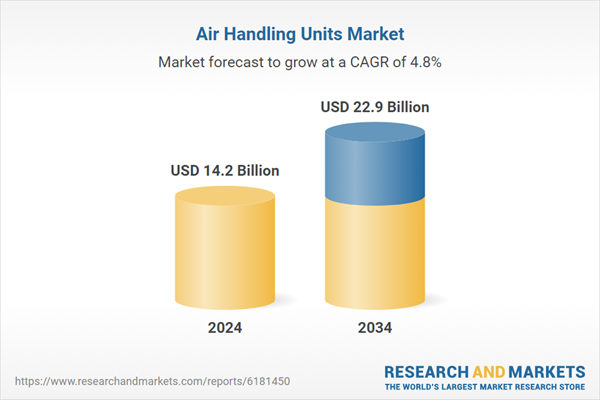Market expansion is driven by the growing demand for better indoor air quality (IAQ), especially in sectors like healthcare, where effective air filtration is directly tied to infection control and patient well-being. As awareness around IAQ grows, demand for AHUs integrated with high-efficiency filtration and antimicrobial features continues to rise. However, adoption remains challenged by the high initial cost of advanced AHUs, particularly those with features such as energy recovery, IoT connectivity, and variable air volume (VAV) systems. Units with energy recovery technology can cost between USD 10,000 and USD 30,000, depending on their capacity and features, making it difficult for smaller businesses to invest. At the same time, manufacturers are accelerating R&D to improve performance and reduce long-term operating costs. Companies are launching energy-optimized models to cater to sustainability requirements, particularly in commercial sectors governed by strict building codes and energy-efficiency standards. These innovations are reshaping how air handling systems are integrated into infrastructure planning and environmental compliance efforts.
The filter component segment generated USD 4.1 billion in 2024, with filtration remaining essential in maintaining IAQ by removing airborne contaminants like pathogens, dust, and allergens. The post-pandemic focus on health and hygiene has led to increased use of HEPA, ULPA, and activated carbon filters across hospitals, labs, and high-tech facilities. These filters not only protect human health but also prevent particulate damage to sensitive equipment, making them indispensable across industries.
The commercial segment generated a 50.4% share in 2024. Regulatory pressure to meet energy conservation goals continues to push commercial property developers toward advanced and energy-efficient AHU installations. These units help reduce energy bills while ensuring compliance with mandatory environmental standards.
U.S. Air Handling Units Market held 78.2% share in 2024. The mature nature of the U.S. HVAC market, combined with consistent retrofitting activities across commercial and public buildings, has driven steady demand. Both the U.S. and Canada enforce rigorous IAQ and energy efficiency policies, accelerating AHU adoption.
Key players in the Global Air Handling Units Market include Carrier Global Corporation, Daikin Industries Ltd., Bosch Thermotechnology GmbH, CIAT Group, FläktGroup Holding GmbH, Trane Technologies plc, TROX GmbH, Systemair AB, Zehnder Group International AG, Mitsubishi Electric Corporation, LG Electronics Inc., Lennox International Inc., Johnson Controls International PLC, Munters Group AB, and Hitachi Ltd. Key strategies adopted by companies in the Global Air Handling Units Market to strengthen their market position include aggressive investment in R&D, product line expansions, and integration of smart technologies to enable real-time performance monitoring and control. Several manufacturers are introducing modular, scalable AHU units tailored to fit both new builds and retrofit projects. Partnerships with commercial real estate developers and healthcare infrastructure planners are also growing, helping companies align product development with evolving building standards.
Comprehensive Market Analysis and Forecast
- Industry trends, key growth drivers, challenges, future opportunities, and regulatory landscape
- Competitive landscape with Porter’s Five Forces and PESTEL analysis
- Market size, segmentation, and regional forecasts
- In-depth company profiles, business strategies, financial insights, and SWOT analysis
This product will be delivered within 2-4 business days.
Table of Contents
Companies Mentioned
The companies profiled in this Air Handling Units market report include:- Bosch Thermotechnology GmbH
- Carrier Global Corporation
- CIAT Group
- Daikin Industries, Ltd.
- FläktGroup Holding GmbH
- Hitachi, Ltd.
- Johnson Controls International PLC
- Lennox International Inc.
- LG Electronics Inc.
- Mitsubishi Electric Corporation
- Munters Group AB
- Systemair AB
- Trane Technologies plc
- TROX GmbH
- Zehnder Group International AG
Table Information
| Report Attribute | Details |
|---|---|
| No. of Pages | 160 |
| Published | October 2025 |
| Forecast Period | 2024 - 2034 |
| Estimated Market Value ( USD | $ 14.2 Billion |
| Forecasted Market Value ( USD | $ 22.9 Billion |
| Compound Annual Growth Rate | 4.8% |
| Regions Covered | Global |
| No. of Companies Mentioned | 16 |









